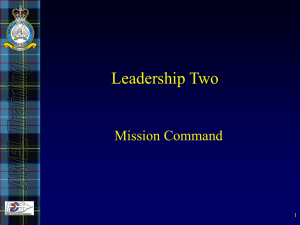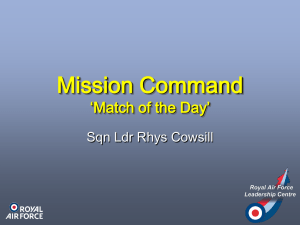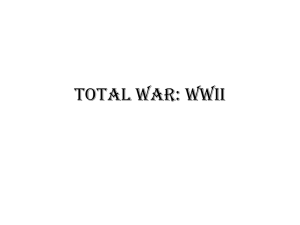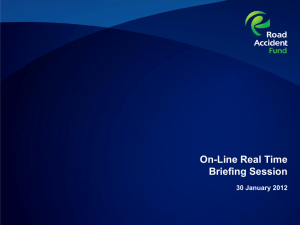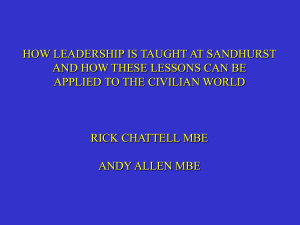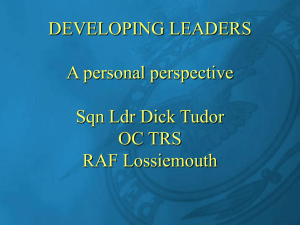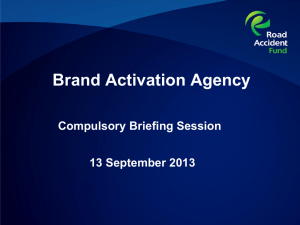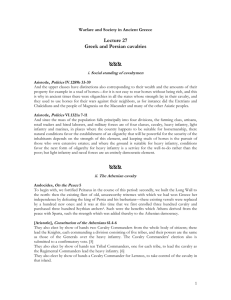Mission Command - Royal Air Force
advertisement
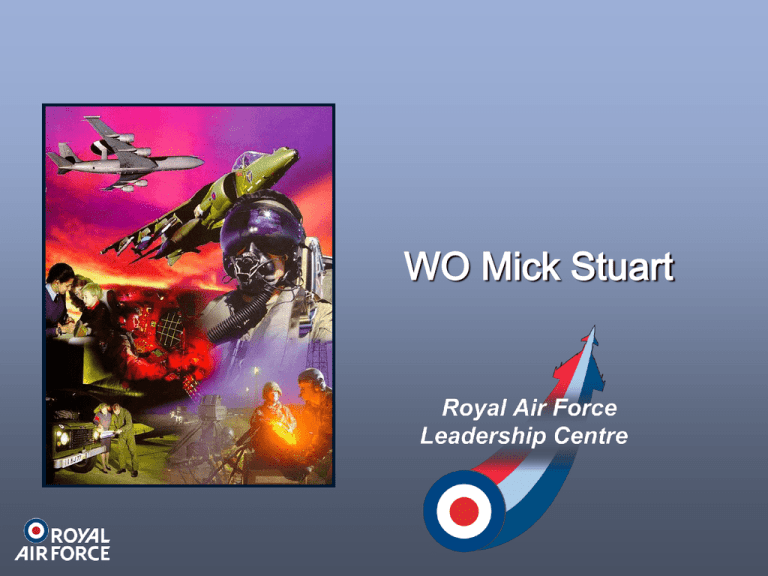
WO Mick Stuart RAF LC Objectives Leadership is the most cost effective way of improving operational effectiveness. Leadership in the RAF can move from good to outstanding. Our intent is to continue to discover, develop and deliver means of improving Leadership. RAF LC Objectives By 2010 Leaders at all levels will: - Embrace Mission Command as an everyday practice. - Realise the importance of exercising each Leadership Attribute in achieving outstanding performance. - Realise the importance of being able to adopt a variety of Leadership styles and approaches. RAF LC Objectives The RAFLC will: - Provide Leadership Policy for the RAF. - Align all Leadership Training Agencies to implement a coherent and consistent Leadership Development Strategy. - Provide practical support to Training Agencies and RAF personnel. - Sponsor education in Leadership and Research into RAF Leadership issues. RAF Strategy Document RAF LEADERSHIP CENTRE WEBSITE Accessing the RAF Leadership Centre Website http://www.cranwell.raf.r.mil.uk/live/ RAF_Leadership_Centre /Index.htm MISSION COMMAND SCOPE Origins. Use and Development: 1805 to 2006. Introduction to British Military Doctrine. Principles of Mission Command. ‘Mechanics.’ Culture. Threats and Opportunities. Battle of Trafalgar 21 Oct 1805 Band of Brothers Nelson’s Orders for Trafalgar ‘England expects that every man will do his duty.’ ‘No captain will do so wrong if he puts his ship alongside that of the enemy.’ Jena and Auerstadt 14 October 1806 PRUSSIA (Professionals and hot favourites) vs FRANCE (Upstart peasants – New Manager) NAPOLEON BONAPARTE SCHARNHORST ‘We fought bravely enough, but not cleverly enough.’ CARL von CLAUSEWITZ ‘On War’ (published posthumously 1832) CLAUSEWITZ’ LEGACY The Fog of War. The Friction of War. The importance of speed of decision making. Findings of Scharnhorst’s ‘Board of Inquiry’ The Prussian Army was run as a machine, with iron discipline, because the morale of the troops was low. Officers tried to counter chaos of battle by using mathematical principles. Nobody took action without orders. Highly centralised and process-dominated. It used ‘Befehltaktik’ – i.e. based on Orders. Findings of Scharnhorst’s ‘Board of Inquiry’ Napoleon was able to communicate very rapidly with his Marshals. He explained his intentions, as well as what he wanted them to do. He expected them to use their initiative. They did! The result was a very high tempo – a very fast ‘OODA loop.’ The OODA Loop Observation Action Orientation Decision Reforms to the Prussian Army The need for speed of decision making was recognised. Officers were trained and authorised to make realtime decisions at low level. Philosophy that it was better to act now with good intentions than to wait for the ‘right’ order. Doing nothing was a greater sin than making the wrong decision. Orders from above could not possibly give the officer on the ground all the guidance he would need. Field Marshal Von Moltke Father of ‘Auftragstaktik.’ “Obedience is a principle, but the man stands above the principle.” Auftragstaktik Senior commanders should not order more than was absolutely necessary but should ensure the goal was clear. In case of doubt, subordinate commanders should seize the initiative. Franco Prussian War 1870 The Great War 1914 The OODA Loop Observation Action Orientation Decision Sturm-Bataillione (Storm Battalion) Storm Trooper General Ludendorff Auftragstaktik Between the Wars Germany (the Losers!) Develops ‘an Army of 100,000 officers.’ Training centred on ‘thinking obedience.’ Trust becomes central to military doctrine. Everyone expected to learn, and be able to do, the job 2 levels up. Proves very effective in coping with and using the chaos of the battlefield. British Army (the Victors!) Reverts to ‘huntin’ shootin’ an’ fishin.’ Prefers to try to control the chaos of the battlefield. Designs a ‘Master plan.’ Master plan specifies in great detail precisely what everyone has to do. Yet, orders are not considered absolute. Result is a lot of debating and delay – very slow OODA Loop. The OODA Loop Observation Action Orientation Decision Second World War Royal Air Force Keith Park – AOC 11 Gp Hugh Dowding – CinC Fighter Command Trafford Leigh Mallory – 12 Gp Sqn Ldr ‘Sailor’ Malan Wg Cdr Stanford-Tuck Royal Air Force Unusually, prepares to fight the NEXT war. Dowding designs ‘integrated defence system’ for Battle of Britain (NEC?). Delegates responsibility for the fighting to Group Commanders. Allows for a very fast OODA Loop. One of the main reasons for the defeat of the Luftwaffe. ‘In a nut-shell’ Germany has outstanding first half using Auftragstaktik from the ‘off.’ Big wins away in Poland, Czechoslovakia, Holland, Belgium France etc. etc. Manager substitutes Befehltaktik for Auftragstaktik just after half time. Germany loses away in Russia (Stalingrad City). Loses to new Combined Services (US/UK). Loses at home trying to play 2 games at once. A Key Lesson… ‘If an operating philosophy is to deliver a strategic advantage its application must be inculcated, practiced and seamlessly applied throughout the organisation.’ US Army Philosophy Invest all authority and knowledge in the officers No need to burden the troops with more information than they will need for the immediate future Make the officers easily identifiable! Cold War Static posturing. Everyone told what they had to do (Befehltaktik?). Not ‘manoeuvre warfare.’ Little need for Auftragstaktik. But!! BAOR is seriously out-numbered and so… Field Marshal Bagnall KCB GCB CVO MC* 1986 – Introduces principles of Auftragstaktik to UK Military doctrine and influences NATO doctrine. Doctrine becomes known as ‘Mission Command.’ Great idea! ……but nobody knows about it. Principles The 4 Enduring Tenets Timely decision making The importance of understanding the senior leader’s intent A clear responsibility to fulfil that intent An ability on the part of the subordinate to meet the superior’s intent Required Leadership Styles Decentralised decision making (formal delegation/empowerment) Freedom (and speed) of action Initiative Required Followership There is a fundamental requirement on everyone’s part to act (or decide not to act, if that is the right thing to do) within the framework of the Senior Leader’s intent Waiting to be told is not an option! Required Followership Is designed to facilitate effective action under chaotic and confusing conditions. Is based on trust. Is intended to unify autonomy and alignment – ‘unity of effort’. The Basic’s Telling someone ‘What to do’ AND Why? NOT ‘How to do it’ Mechanics Mission Command The Commander: • Briefs his intent to 2 levels down. • Explains the limitations, e.g. time, boundaries, must do, mustn’t do. • Allocates resources. • States WHAT is to be achieved, not HOW it is to be achieved. • Gives decision-making criteria. Mission Command The Subordinate Commander: • Understands ‘my role in his plan’ 2 levels up. • Devises his own plan to play his part in achieving the commander’s intent. • Asks for more resources if needed, but offers back resources not needed. • Briefs his subordinates 2 levels down. and so forth… ‘Gladiator’ “At My Signal Unleash Hell” The Command Chain Caesar Maximus Archers & Artillery Roman Infantry Roman Cavalry Mission Statements Own Mission: Task(s) + Purpose Task – The What Purpose – The Why Caesar T: Pacify the German tribes P: Bring peace to the Empire’s northern borders T: Defeat militant German tribes Maximus P: Bring peace to the northern borders Supporting Effort Archers & artillery T: Force German forces out of the woods P: Enable infantry to engage the enemy in the open Roman Infantry T: Fix enemy forces in the open P: Enable Cavalry, on the main effort, to attack the enemy from the rear Roman Cavalry T: Kill German tribal leader and his bodyguard P: Cause the culmination of the militant tribes Mission Statements Own Mission: Task + Purpose Subordinate 1: Task + Purpose Subordinate 2: Task + Purpose Subordinate 3: Task + Purpose The missions assigned to subordinates, together, fulfil the mission assigned to the commander. Achieving Unity of Effort The Commander’s Intent Main and Supporting Efforts Mission Statements Maximus’ Orders to his Legions (1) Mission: Defeat militant German tribes in order to bring peace to the northern borders Intent: We will force the enemy out of the forest so we can fix him in the open. Once he is fixed, we will surprise him by an attack in the rear, striking to destroy his leadership - the decisive element of the operation. Once his leadership is destroyed, I believe we will break the will of the German tribes, thus eventually bring peace to the Northern borders Maximus’ Orders to his Legions (2) Main Effort: Killing of enemy leadership by the cavalry Scheme of Manoeuvre: Cavalry preparatory move to FUP in cover, signal once in position. Artillery and archers then force enemy out of the forest using fire. Infantry advance into open ground, to lure the enemy further into the open, and then fix him. Cavalry then strike from the forest into the enemy’s rear, gaining shock and surprise, to kill the enemy leadership. Once enemy is reduced to a disorganised rabble, massacre as many as possible. Enslave the rest. Maximus’ Orders to his Legions Subordinate Missions Archers and Artillery T: Force German forces out of the woods P: Enable infantry to engage the enemy in the open Infantry T: Fix enemy forces in the open P: Enable Cavalry, on the main effort, to attack the enemy from the rear Cavalry T: Kill German tribal leader and his bodyguard P: Cause the culmination of the militant tribes Culture The Culture Required for Effective Mission Command The Commander retains ultimate responsibility for decisions but: • He must genuinely empower his people. • He must trust his subordinates. Everyone must act as a leader. A decision to act now in accordance with commander’s intent, rather than to wait for orders, is imperative. What happens if the subordinate’s plan goes wrong? Blame culture? Who’s fault is it anyway? What can we do to improve? What about resources? What about rewards? Threats and Opportunities The greatest threat to the successful implementation of Mission Command is a belief that technology will allow leadership to be supplanted by control. The greatest challenge is to use Mission Leadership in every-day episodes of leadership at all levels and to become proficient in its use. Final Words Trust your people. Empower and give them responsibility. Let them use their initiative. Let them get on with it, even if they occasionally get it wrong. Task(What)& Purpose(Why) = Mission. Endeavour to use Mission Command as a daily routine. Don’t tell people how to do things, tell them what to do and let them surprise you with their ingenuity. ~ George S. Patton Questions?
